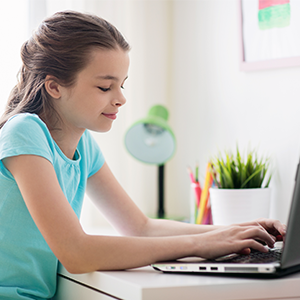Does your child have a particular passion that could be explored more
through writing or photography? Blogging is an educational way for kids to
practice their writing and research skills over the summer while
interacting with a receptive audience at the same time.
Take a cue from teachers.
Pernille Ripp, a 5th grade teacher, introduced blogging to her students
four years ago. She says the response has been overwhelmingly positive.
“Parents love that it provides them with a look into what is happening with
their child in school and what their child is thinking. It also allows
extended family to be part of the learning conversation. My students love
it because of the conversation it starts and the ideas they can get from
others,” she says.
Why blog?
Not only are kids learning to write to a target audience, they are
enhancing their writing skills in the process.
“I’ve seen the rates of student writing really increase,” says Sue Gorman,
an Innovation Learning Consultant K-12 and adjunct professor for the
Institute of Professional Educator Development for the University of
Wisconsin-Parkside. “You aren’t just turning this [writing assignment] into
your teacher, you are turning this in as a global writer, a global
thinker.”
Get to know blogging.
If you aren’t sure how blogging works, open an account and play around with
the platform. Learn how privacy settings work and familiarize yourself with
the terms and conditions associated with the platform. Explore blogs your
child likes. If your child is interested in art or photography, explore
some professional artist and photography blogs. Consider what you and your
child find attractive about these sites.
When is a good age to start blogging?
Whether a child is ready for blogging or any other type of social media
really depends on your child and her maturity level. Some teachers start
kids blogging as early as second and third grades to flex their writing
muscles with an encouraging audience. Educators use carefully moderated and
secure sites like KidBlog.org.
Blog options.
For the under 12 crowd, Kidzworld
offers a safe, moderated platform for kids to blog with parental consent.
Your child could also blog through a free platform like Blogger or
WordPress; however, both platforms require that users are 13 and over. In
this case, you might want to create a family blog that you facilitate. Make
the blog private and invite family and friends to follow.
Since posts can still be forwarded (and nothing posted online is truly
private), you’ll still want to be careful about your child revealing too
much personal information. (More on that shortly.)
Tumblr, Twitter and Instagram are especially popular among teens. These are
“short-form multi-media” blogging sites. Members post photos, video and
short posts. (Due to some of the content, these social media sites are not
suggested for kids younger than 13.)
Community blogs.
Gather a few of your child’s friends who also like to write and encourage
them to start a blog together. They can take turns posting and responding
to each other’s work.
Unsure where to begin?
Focus your child on a particular topic or passion. Does she love to read?
Encourage her to create an online book club where she posts reviews of
different books she reads. Teach her how to link to the book and the
author.
If your child loves photography, have him take pictures and create a photo
blog.
Safety considerations.
Naturally, your child’s safety will be on the top of your mind.
Create a digital citizenship contract with your child to clarify your
rules, expectations and consequences. Have your child sign the contract.
Talk about the types of information she should never share like:
-
Full name (she could choose a nickname instead of using her real
first name if that makes you more comfortable) -
Year of birth
-
The name and location of her school (including in photos)
-
Home address
If she includes a photo of herself, make sure it doesn’t leave a digital
footprint that reveals your location. Turn off geotagging by going into
your privacy settings on your phone and turn off the location services
under your camera app.
At least at first, review her posts before they go live to make sure she
isn’t inadvertently sharing information that could put her personal safety
or identity at risk.
Discourage your child from using the blog like a private journal. He should
ask himself questions like: Am I okay with Grandma or my teacher seeing
this? Would I be embarrassed if my friends at school read this?
Post an email account on the site that goes to you first so you can review
any correspondence that individuals are sending. This is a good way for you
to filter mean-spirited emails that your child doesn’t need to see. You
might also show him examples of what spam and phishing emails look like.
Set up privacy settings to approve comments before they are posted.
Hopefully, your child won’t receive negative comments, but discuss the best
ways to handle these types of scenarios and encourage your child to come to
you first before responding, especially if she is upset or isn’t sure how
to manage the issue.
Other tips and resources:
If you’re unsure about a particular app or social media platform, check out CommonSenseMedia.org, which
posts reviews and recommendations for parents.
Set up a Google Alert with your child’s name so you can be notified if
their name appears online somewhere.


